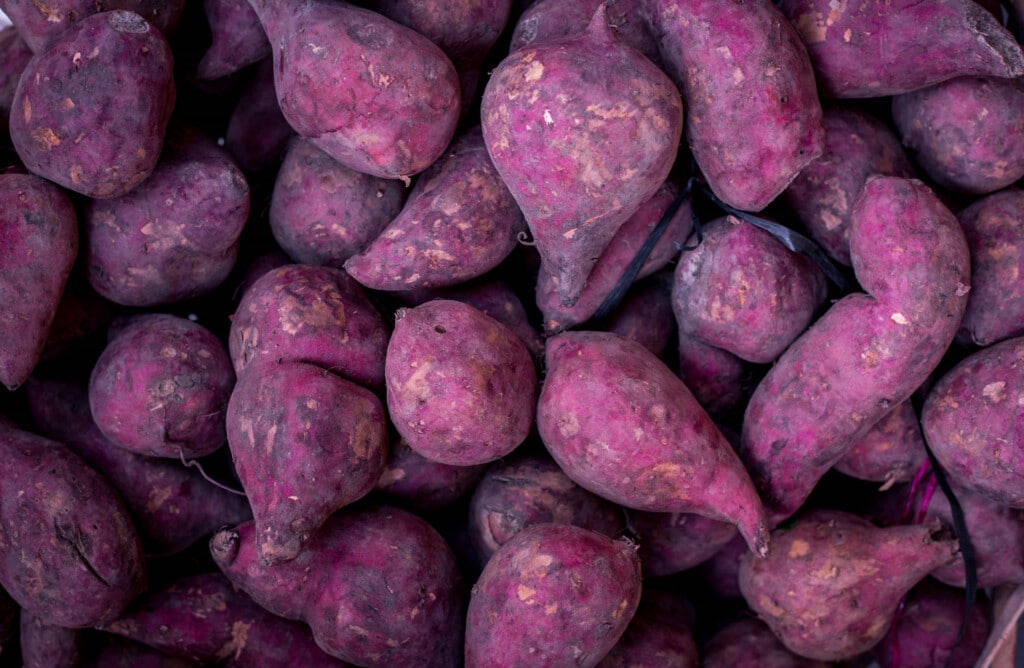In the age of all things keto and low-carb, potatoes and sweet potatoes tend to get villainized. Yes, they have a high starch content. On the other hand, potatoes pack much more than carbs. Dive into the nutrient profile and you’ll find that both regular and sweet potatoes contain many micronutrients, including calcium, potassium and vitamin C. So, as long as you eat potatoes in something close to their natural state (i.e., not as potato chips), you can enjoy them regularly.
And you can up the nutrition ante by trading regular spuds for these vibrant violet beauties.

What are Purple Potatoes?
Sweet potatoes are distinct from “regular” potatoes, of course. You can tell that just from the taste, not to mention the density of the starch. Potatoes are edible tubers in the nightshade family, while sweet potatoes are actually roots in the morning glory family. (Plant taxonomy is complicated—but this distinction makes sense if you’re familiar with sweet potato vines, which grow with the same enthusiasm as morning glories.)
While most Americans are very familiar with the vibrant orange variety of sweet potato, which crop up every autumn in pies and on Thanksgiving platters, these tasty veggies come in a variety of hues, from pale yellow to deep purple. Purple potatoes are sweet, yes, although less so than orange ones. Some people describe the purple variety’s flavor as more earthy or nutty. For macronutrient content, they’re similar to russet potatoes—except that purple potatoes offer about four times as many antioxidants as russets due to the compounds that cause their violet hue.
Naturally, purple sweet potato nutrition varies by size. As a rough guide, here’s what you’ll find in one 5-ounce serving:
- 165 calories
- zero grams of fat
- 3 grams of protein
- 16 grams of carbohydrates (including 5 grams of fiber, 5 grams of sugar)
- Purple potatoes are great sources of many micronutrients, particularly vitamin C, vitamin B6, potassium and copper.
RELATED: The Powerful Antioxidant You’re Ignoring
Health Benefits of Purple Potatoes
Purple Potatoes are Loaded with Antioxidants
For most whole foods, the darker and deeper the color, the higher the antioxidant level. Sweet potatoes with orange flesh are rich in beta carotene (just as carrots are), while those with purple flesh are rich in anthocyanins (as with blueberries), a type of flavonoid. Great news: Anthocyanins have been linked to decreased risk for many chronic diseases. (p.s. Eat the skin to score the maximum amount of health benefits!)
Purple Potatoes Help Fight Disease
In one study published in The Journal of Nutrition, men who ate purple potatoes instead of an equal amount of white potatoes daily for six weeks had less inflammation, along with higher levels of carotenoids, anthocyanins, and phenolic acids (all disease-preventing antioxidants). Over time, this might be linked to lower blood pressure, lower cholesterol, and reduced risks for heart disease and certain kinds of cancer.
Purple Potatoes Lower Your Blood Pressure
Yes, that’s right. Purple potatoes keep you chill. Another study in Plant Foods for Human Nutrition found that in just two weeks of consuming one medium purple potato daily instead of one medium white potato, blood pressure lowered significantly.
Purple Potatoes Also Reduce Blood Sugar
Purple potatoes may be better than their paler cousins in terms of blood-sugar impact as well. Research in the journal Food & Function discovered that the higher level of antioxidants in these dark-hued tubers may be related to a lower glycemic index. Although sweet potatoes of all colors have more sugar, they’re actually considered “low” on the glycemic index scale compared to regular white potatoes. This means your blood sugar will rise more slowly, preventing a sharp spike and subsequent crash.
RELATED: How Gut Health Impacts Blood Sugar
How to Eat Purple Potatoes
You can use purple potatoes in all the ways you would use sweet potatoes or regular russet potatoes. Boil, bake, mash, roast, and even air-fry—they’ll all taste great.
Use an equal amount of purple spuds in place of sweet potatoes in these sweet and savory recipes. Your body will appreciate the antioxidant-rich fix—and your eyes will feast on that bold pop of color, brightening your meal.